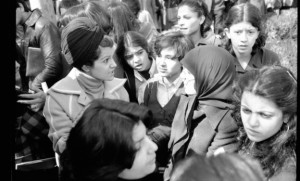
Symposium: When does a Revolution Start? Part II
Saturday 19 September 2015, 12–5pm
Free, tickets available via Eventbrite
This is an event to accompany the exhibition Hengameh Golestan: Witness 1979.
‘Women have been veiled and unveiled by force but they will remain enfolded and covered by physical and psychological traces of their modes of acceptance or rejection of the veil’ - Farzaneh Milani.
The condition of unveiling (1936) or veiling (1979) has been imposed on women in Iran by political powers for the last 80 years, as a result women have been deeply concerned with the notions of exposure and concealment for some time. What should be remembered is that, whilst these physical conditions appeared overnight, the individual psychological and emotional response has obviously not followed the same timeline. Farzaneh Milani’s description of women responding to veiling in its physical and metaphorical forms brings to attention a very contemporary concern surrounding veiling.
The unique photographs by Hengameh Golestan show women protesting on the 8th of March 1979, after Ruhollah Khomeini’s decree on the compulsory hijab. This is the most important day of the feminist movement in Iran where women spontaneously came out onto the streets to protest against the decision.
This two-day symposium at The Showroom will address different works and discourses around this period of history and its resonances today. It will focus on discussions around gender, protest and representation through academic papers and artistic practices responding to the event and to start mapping a wider understanding.
Part I was held at The Showroom on 5 September 2015.
Programme
12–1pm: Dr. Ziba Mir-hosseini, Changing Politics of Iranian Women.
Since the 1979 Revolution, Iranian women’s activism has conventionally been viewed as a polarized conflict between ‘secular’ and ‘Islamic’ ideologies and forces. This view, I contend, masks the real struggle, which has been between ideologies and practices of despotism and patriarchy, on the one hand, and those of democracy, pluralism and gender equality on the other. A growing popular understanding of the nature of this real battle has been one of many unintended consequences of the merger of religion and state in post-revolutionary Iran. In this light, I place the changing nature of Iranian women’s activism and gender consciousness in the wider context of the socio-political developments that by 2009 led to the emergence of the Green Movement – a civil rights movement with women at the forefront.
1–2pm: Screening of Nooshin Farhid, Shallow Water, Deep Skin.
The main video work Shallow Water, Deep Skin has as its focus a single character – the political activist and entomologist Shahin Nawai. Shahin was until recently undertaking research at The Museum of Natural History in Berlin where she worked for a number of years. In tandem with her entomological work in Tehran University Shahin was a founder member of the largest women’s organisation in the immediate aftermath of the Iranian revolution 1979. The organisation was a platform for women to mobilise against the infringement of their rights by the Islamic government. She was forced to leave her country and live in exile. The work by Farhid explores two seemingly different and what might appear irreconcilable differences – the scientific study of the insect world
and the world of political activism. Her approach is to explore, from the outset two historically familiar paradigms of activity, and, as distinct paradigms, establish their frameworks, terms of reference, and boundaries. The video explores these perceived boundaries and introduces elements of fantasy and imagination into their individually complex narratives. What emerges is a set of fragmented narratives that intersect and interweave through these boundary laden activities, breaking down their homogeneity and opening up new spaces of conceptual potential. There are elements of conflict, humour, fear and pure documentation drawn together from the process of precision editing of visual and textual material derived from a range of sources including original footage filmed in Berlin, Scotland, Suffolk and Oxfordshire.
2–2.30pm: Break
2.30–3.30pm: Shahin Nawai, National Unity of Women.
3.30-4.30: Panel discussion: Shahin Nawai, Nooshin Fahrid, Ziba Mir-hosseini chaired by Azadeh Fatehrad and Louise Shelley.
5pm: End
Programme
12–1pm: Dr. Ziba Mir-hosseini, Changing Politics of Iranian Women.
Since the 1979 Revolution, Iranian women’s activism has conventionally been viewed as a polarized conflict between ‘secular’ and ‘Islamic’ ideologies and forces. This view, I contend, masks the real struggle, which has been between ideologies and practices of despotism and patriarchy, on the one hand, and those of democracy, pluralism and gender equality on the other. A growing popular understanding of the nature of this real battle has been one of many unintended consequences of the merger of religion and state in post-revolutionary Iran. In this light, I place the changing nature of Iranian women’s activism and gender consciousness in the wider context of the socio-political developments that by 2009 led to the emergence of the Green Movement – a civil rights movement with women at the forefront.
1–2pm: Screening of Nooshin Farhid, Shallow Water, Deep Skin.
The main video work Shallow Water, Deep Skin has as its focus a single character – the political activist and entomologist Shahin Nawai. Shahin was until recently undertaking research at The Museum of Natural History in Berlin where she worked for a number of years. In tandem with her entomological work in Tehran University Shahin was a founder member of the largest women’s organisation in the immediate aftermath of the Iranian revolution 1979. The organisation was a platform for women to mobilise against the infringement of their rights by the Islamic government. She was forced to leave her country and live in exile. The work by Farhid explores two seemingly different and what might appear irreconcilable differences – the scientific study of the insect world
and the world of political activism. Her approach is to explore, from the outset two historically familiar paradigms of activity, and, as distinct paradigms, establish their frameworks, terms of reference, and boundaries. The video explores these perceived boundaries and introduces elements of fantasy and imagination into their individually complex narratives. What emerges is a set of fragmented narratives that intersect and interweave through these boundary laden activities, breaking down their homogeneity and opening up new spaces of conceptual potential. There are elements of conflict, humour, fear and pure documentation drawn together from the process of precision editing of visual and textual material derived from a range of sources including original footage filmed in Berlin, Scotland, Suffolk and Oxfordshire.
2–2.30pm: Break
2.30–3.30pm: Shahin Nawai, National Unity of Women.
3.30-4.30: Panel discussion: Shahin Nawai, Nooshin Fahrid, Ziba Mir-hosseini chaired by Azadeh Fatehrad and Louise Shelley.
5pm: End
Related
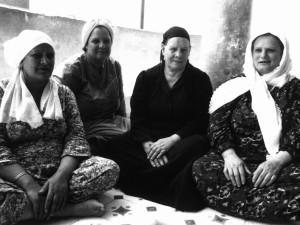
Event
Screening: Hidden Faces by Kim Longinotto
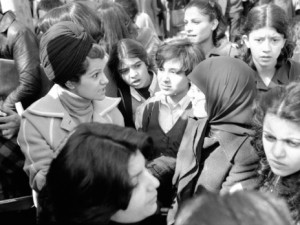
Event
Symposium: When does a Revolution Start? Part I
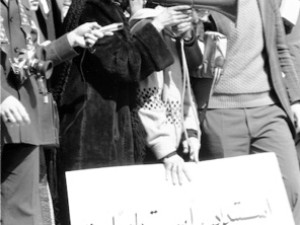
Event
Open discussion with Hengameh Golestan and Justice for Domestic Workers
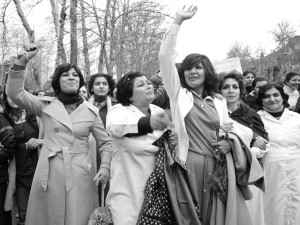
Exhibition
Hengameh Golestan: Witness 1979
–
Film looking at The Showroom’s local work
Video
Film looking at The Showroom’s local work